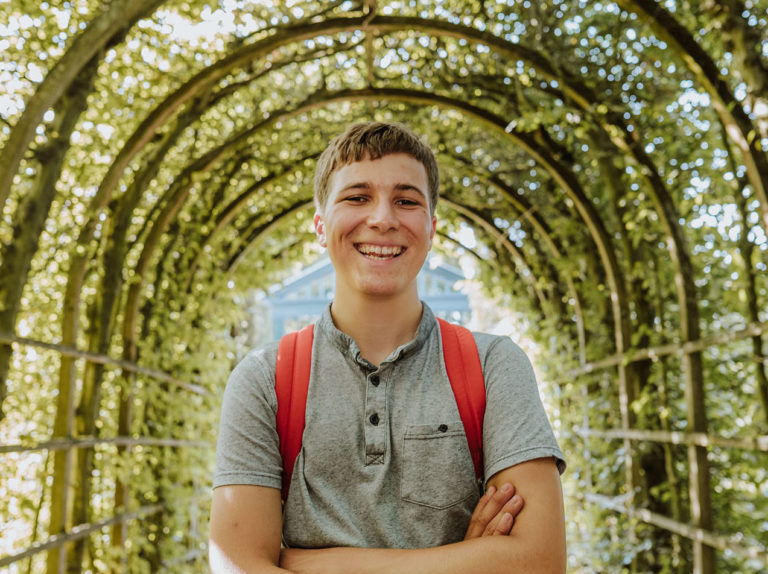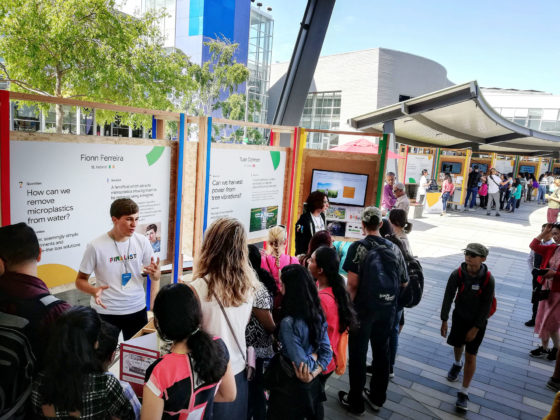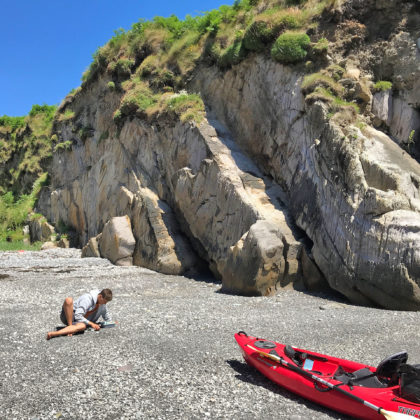
Fionn won the Google Science Fair
The boy wonder who will save us from plastic
What kind of kid comes up with a game-changing scientific innovation by 18? Fionn Ferreira thinks it might have something to do with growing up in a really remote area in Ireland. In West Cork, his closest neighbors were a fifteen minute drive away. So was his school. He’s an only child – his father builds boats and his mother designs paper model kits – and grew up kayaking the tiny islands just off the coast by himself, and camping out alone a week at a time. ‘Untangling my thoughts’, as he calls it. When he wasn’t outdoors he was at home dismantling stuff he’d picked up in charity shops: old radios, broken cd drives, an iPod.
‘I liked to see how they worked. Sometimes I couldn’t get them to work again but that wasn’t a problem, because they were broken to start with. And these things are often beautiful on the inside. That cd drive could go right up on your wall.’
I like to see how things work
He doesn’t drink – it’s unproductive, he says. And he hates being unproductive. There are so many things to figure out, and so little time to do it in: why so many stones on the beach are plastered with both oil-spill and plastic, for example. And whether it’s possible to use that unlikely marriage of substances to get microplastics out of water.
Turns out, it is.
It took months of experiments – even building his own spectrometer from wood – to settle on the method that won him the Google Science Fair award last July. He won 50.000 dollars and met with big companies and big minds like Vinton Cerf, founder of the internet, or investor and entrepreneur Enrico Palmira.
Fionn during the poster presentation at the Google Science Fair
Seeing your environment change
‘At the time, I was just playing around’, he says. ‘Because I lived in a very rural area, I was always there, close to the water, kayaking and swimming. I saw my environment changing – there’s a lot of plastic waste on the beaches. And I realized the plastic you see isn’t all, there are microplastics that are everywhere – from paint to toothpaste – in anything you wash away. And currently there’s no way to remove these from the water.’
But when Fionn noticed a rock covered in oil spill and plastic, it got him thinking. ‘I was like: hmmm, plastic sticks to oil? And I got back home to see if it worked with vegetable oil too. It did. I thought: this is cool. Then I started thinking about science in general.’
It took me months and over a thousand tests
Things got really interesting when he saw a video on ferrofluids – oil mixed with magnetite. The magnetite makes the oil magnetic. So Fionn decided to add magnetite to his oil. Now he could use a common magnet to extract plastic from water: the plastic sticks to the oil, then magnetite in the oil sticks to the magnet, and everything can be removed together. It sounds like a wildly simple trick, but ‘of course it took a lot of testing and experimenting. It took me months and over a thousand tests’, Fionn explains.
True to form, Fionn decided to build his own testing equipment. ‘I needed a visible light spectrometer’, he says. ‘But that would cost me 7000 euros. So I started building using stuff like Lego and Arduino microcontrollers. I tested it on potassium permanganate solutions to figure out if it was accurate. And it was. The only problem was that it all caught fire and I had to start all over again.’
After building and calibrating his second – wooden – spectrometer, he built a microscope to test his testing method. Then he coded a piece in Adobe Photoshop to analyze the pictures he took with this microscope, so he could count how many pixels were covered in plastic. ‘That was mostly to save time, but it was kind of cool to do’, he says.
He ran up to 8000 tests using the ten most common microplastics, like PET and microbeads he extracted from facial scrubs or toothpaste. Experimenting with the proportions, he found that on average he was able to extract 87 percent of the plastics. On microfibers, his method was able to extract 95 percent – way more than the 50 percent he had expected when he started.
Fionn at home on the beach
A clean and simple process
The great thing is that it’s also a very clean process. Fionn used waste vegetable oil and magnetite ore, the most common mineral on earth. ‘It’s rust powder and not harmful to the environment’, he says.
‘Its simple, he says. ‘And that’s what makes it such a good method. It’s also attractive because it’s cheap: you can use waste oil and one of the least expensive minerals on earth, and you can reuse them both.’ He is able to recover 99 percent of both the oil and magnetite each time.
It seems crazy that no one has thought of this simple, elegant solution before. But Fionn thinks that’s because it’s out of the box thinking. ‘No one ever associated oil and magnetite with plastics’, he says. ‘I think it stayed unidentified because it’s a bridging of the sciences.’
He brought his idea to several science fairs and won. It was the Intel ISEF competition of 2018 that won him his own dwarf planet. Fionnferreira – formerly known as dwarf planet 34497 – is only 100.000 kilometers away from Ben Feringa’s planet. ‘I was worried though, that it might crash into earth’, he says smiling. ‘Because their trajectories are very erratic. But they promised me it wouldn’t. At least not for the first 120 years.’
I don’t need to make money out of it. I just want it to be used.
But that honour was nothing compared to the Google Science Fair, which got him into Google Headquarters, introduced him to the editors in chief of Scientific American and National Geographic, and got him mentorships with big companies that might run with his idea.
Now? His mailbox is bursting with over 6000 emails a day. When he arrived in Groningen last week he had six Skype interviews, which he took in his still empty room. But he will keep his idea in the public domain, he says. Anyone may use it. ‘I don’t need to make money out of it. I just want it to be used.’
His story brings to mind that of Boyan Slat, who invented the Ocean CleanUp project to get rid of the plastic soup when he was 16 years old. Slat started a business and has been trying to realize his plan for nine years now. But Fionn is taking a different approach.
‘I’m going to study’, Ferreira says. ‘I want to make the most of that; I want to play and explore and figure things out. Maybe in the environmental side of it, like in chemical engineering. I just want to solve more problems and propose solutions, and let other people actually do it.’
He smiles a little. ‘I think that is more productive.’



